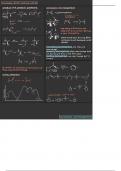Carbocation rearrangement - Study guides, Class notes & Summaries
Looking for the best study guides, study notes and summaries about Carbocation rearrangement? On this page you'll find 26 study documents about Carbocation rearrangement.
Page 2 out of 26 results
Sort by
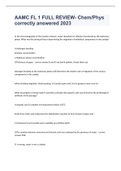
-
AAMC FL 1 FULL REVIEW- Chem/Phys correctly answered 2023
- Exam (elaborations) • 24 pages • 2023
- Available in package deal
-
- $19.99
- + learn more
AAMC FL 1 FULL REVIEW- Chem/Phys correctly answered 2023In the chromatography of the reaction mixture, water absorbed on cellulose functioned as the stationary phase. What was the principal factor determining the migration of individual components in the sample? A.Hydrogen bonding B.Solute concentration C.Stationary phase concentration D.Thickness of paper - correct answer B and D are dumb options. Knock them out. hydrogen bonding to the stationary phase will determine the relative rat...
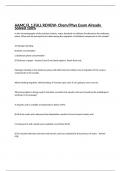
-
AAMC FL 1 FULL REVIEW- Chem/Phys Exam Already Solved 100%
- Exam (elaborations) • 25 pages • 2023
-
- $15.99
- + learn more
In the chromatography of the reaction mixture, water absorbed on cellulose functioned as the stationary phase. What was the principal factor determining the migration of individual components in the sample? A.Hydrogen bonding B.Solute concentration C.Stationary phase concentration D.Thickness of paper - Answer B and D are dumb options. Knock them out. hydrogen bonding to the stationary phase will determine the relative rate of migration of the various components in the sample. When...
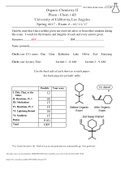
-
Answers Key_Exam 2-University of California, Los Angeles CHEM 14D
- Exam (elaborations) • 7 pages • 2023
-
- $7.99
- + learn more
I. This, That, or the Other (12 pts; 2 pts each) Answer the following questions by inputting the correct answer in the boxes provided next to each question. a) Which of the following could act as a solvent in a reaction with a Grignard reagent? b) Which of the following reactions does not proceed through a concerted mechanism? c) Which reaction will not result in a carbocation rearrangement? d) Which pair represents possible products of the reaction after each step? e) True or False: Trans...
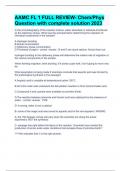
-
AAMC FL 1 FULL REVIEW- Chem/Phys Question with complete solution 2023
- Exam (elaborations) • 17 pages • 2023
-
Available in package deal
-
- $15.49
- + learn more
AAMC FL 1 FULL REVIEW- Chem/Phys Question with complete solution 2023In the chromatography of the reaction mixture, water absorbed on cellulose functioned as the stationary phase. What was the principal factor determining the migration of individual components in the sample? A.Hydrogen bonding B.Solute concentration C.Stationary phase concentration D.Thickness of paper B and D are dumb options. Knock them out. hydrogen bonding to the stationary phase will determine the relative rate of...
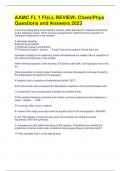
-
AAMC FL 1 FULL REVIEW- Chem/Phys Questions and Answers 2023
- Exam (elaborations) • 17 pages • 2023
-
Available in package deal
-
- $22.49
- + learn more
AAMC FL 1 FULL REVIEW- Chem/Phys Questions and Answers 2023 In the chromatography of the reaction mixture, water absorbed on cellulose functioned as the stationary phase. What was the principal factor determining the migration of individual components in the sample? A.Hydrogen bonding B.Solute concentration C.Stationary phase concentration D.Thickness of paper B and D are dumb options. Knock them out. hydrogen bonding to the stationary phase will determine the relative rate of migrati...
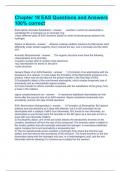
-
Chapter 18 EAS Questions and Answers 100% correct
- Exam (elaborations) • 9 pages • 2023
-
Available in package deal
-
- $12.99
- + learn more
Chapter 18 EAS Questions and Answers 100% correct Electrophilic Aromatic Substitution -reaction in which an electrophile is substituted for a hydrogen on an aromatic ring -many different types of EAS reactions based on what functional group replaces the hydrogen Alkene vs Benzene Alkenes undergo addition reactions but Benzenes react differently under similar reagents. Don't confuse the two, one is Aromatic and the other isn't. Aromatic Requirements The organic structure must...
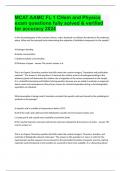
-
MCAT AAMC FL 1 CHem and Physics exam questions fully solved & verified for accuracy 2024
- Exam (elaborations) • 25 pages • 2024
- Available in package deal
-
- $16.49
- + learn more
In the chromatography of the reaction mixture, water absorbed on cellulose functioned as the stationary phase. What was the principal factor determining the migration of individual components in the sample? A.Hydrogen bonding B.Solute concentration C.Stationary phase concentration D.Thickness of paper The correct answer is A. This is an Organic Chemistry question that falls under the content category "Separation and purification methods." The answer to this question is A because the ...
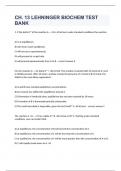
-
Test Bank for Lehninger Principles of Biochemistry 7th Edition by Nelson (complete, questions/answers/rationales)
- Exam (elaborations) • 9 pages • 2023
-
Available in package deal
-
- $14.99
- + learn more
1. If the delta G'° of the reaction A --> B is -40 kJ/mol, under standard conditions the reaction: A) is at equilibrium. B) will never reach equilibrium. C) will not occur spontaneously. D) will proceed at a rapid rate. E) will proceed spontaneously from A to B. E For the reaction A --->B, delta G'° = -60 kJ/mol. The reaction is started with 10 mmol of A; no B is initially present. After 24 hours, analysis reveals the presence of 2 mmol of B, 8 mmol of A. Which is the mo...
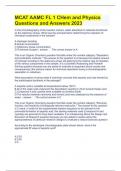
-
MCAT AAMC FL 1 CHem and Physics Questions and Answers 2023
- Exam (elaborations) • 20 pages • 2023
-
Available in package deal
-
- $24.49
- + learn more
MCAT AAMC FL 1 CHem and Physics Questions and Answers 2023 In the chromatography of the reaction mixture, water absorbed on cellulose functioned as the stationary phase. What was the principal factor determining the migration of individual components in the sample? A.Hydrogen bonding B.Solute concentration C.Stationary phase concentration D.Thickness of paper The correct answer is A. This is an Organic Chemistry question that falls under the content category "Separation and purificat...
3/23/2023 lecture notes, lecture 2 with Matt Bowman, Introductory Organic Chemistry I Spring Semester 2023

$6.50 for your textbook summary multiplied by 100 fellow students... Do the math: that's a lot of money! Don't be a thief of your own wallet and start uploading yours now. Discover all about earning on Stuvia



